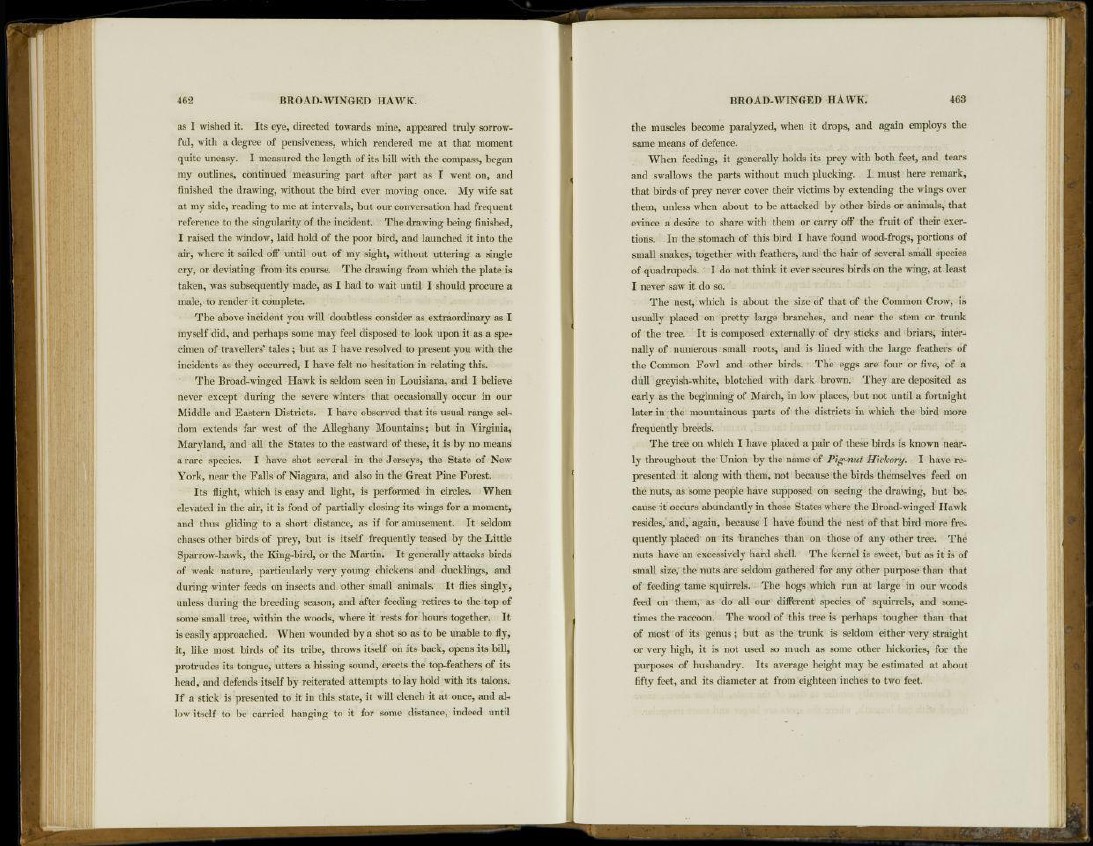
462 BROAD-WINGED HAWK.
as I wished it. Its eye, directed towards mine, appeared truly sorrowful,
with a degree of pensiveness, which rendered me at that moment
quite uneasy. I measured the length of its bill with the compass, began
my outlines, continued measuring part after part as I went on, and
finished the drawing, without the bird ever moving once. My wife sat
at my side, reading to me at intervals, but our conversation had frequent
reference to the singularity of the incident. The drawing being finished,
I raised the window, laid hold of the poor bird, and launched it into the
air, where it sailed off until out of my sight, without uttering a single
cry, or deviating from its course. The drawing from which the plate is
taken, was subsequently made, as I had to wait until I should procure a
male, to render it complete.
The above incident you will doubtless consider as extraordinary as I
myself did, and perhaps some may feel disposed to look upon it as a specimen
of travellers'1 tales ; but as I have resolved to present you with the
incidents as they occurred, I have felt no hesitation in relating this.
The Broad-winged Hawk is seldom seen in Louisiana, and I believe
never except during the severe winters that occasionally occur in our
Middle and Eastern Districts. I have observed that its usual range seldom
extends far west of the Alleghany Mountains; but in Virginia,
Maryland, and all the States to the eastward of these, it is by no means
a rare species. I have shot several in the Jerseys, the State of New
York, near the Falls of Niagara, and also in the Great Pine Forest.
Its flight, which is easy and light, is performed in circles. When
elevated in the air, it is fond of partially closing its wings for a moment,
and thus gliding to a short distance, as if for amusement. It seldom
chases other birds of prey, but is itself frequently teased by the Little
Sparrow-hawk, the King-bird, or the Martin. It generally attacks birds
of weak nature, particularly very young chickens and ducklings, and
during winter feeds on insects and other small animals. It flies singly,
unless during the breeding season, and after feeding retires to the top of
some small tree, within the woods, where it rests for hours together. It
is easily approached. When wounded by a shot so as to be unable to fly,
it, like most birds of its tribe, throws itself on its back, opens its bill,
protrudes its tongue, utters a hissing sound, erects the top-feathers of its
head, and defends itself by reiterated attempts to lay hold with its talons.
If a stick is presented to it in this state, it will clench it at once, and allow
itself to be carried hanging to it for some distance, indeed until
BROAD-WINGED HA^YK. 463
the muscles become paralyzed, when it drops, and again employs the
same means of defence.
When feeding, it generally holds its prey with both feet, and tears
and swallows the parts without much plucking. I must here remark,
that birds of prey never cover their victims by extending the wings over
them, unless when about to be attacked by other birds or animals, that
evince a desire to share with them or carry off the fruit of their exertions.
In the stomach of this bird I have found wood-frogs, portions of
small snakes, together with feathers, and the hair of several small species
of quadrupeds. I do not think it ever secures birds on the wing, at least
I never saw it do so.
The nest, which is about the size of that of the Common Crow, is
usually placed on pretty large branches, and near the stem or trunk
of the tree. It is composed externally of dry sticks and briars, internally
of numerous small roots, and is lined with the large feathers of
the Common Fowl and other birds. The eggs are four or five, of a
dull greyish-white, blotched with dark brown. They are deposited as
early as the beginning of March, in low places, but not until a fortnight
later in the mountainous parts of the districts in which the bird more
frequently breeds.
The tree on which I have placed a pair of these birds is known nearly
throughout the Union by the name of Pig-nut Hickory. I have represented
it along with them, not because the birds themselves feed on
the nuts, as some people have supposed on seeing the drawing, but because
it occurs abundantly in those States where the Broad-winged Hawk
resides, and, again, because I have found the nest of that bird more frequently
placed on its branches than on those of any other tree. The
nuts have an excessively hard shell. The kernel is sweet, but as it is of
small size, the nuts are seldom gathered for any other purpose than that
of feeding tame squirrels. The hogs which run at large in our woods
feed on them, as do all our different species of squirrels, and sometimes
the raccoon. The wood of this tree is perhaps tougher than that
of most of its genus; but as the trunk is seldom either very straight
or very high, it is not used so much as some other hickories, for the
purposes of husbandry. Its average height may be estimated at about
fifty feet, and its diameter at from eighteen inches to two feet.